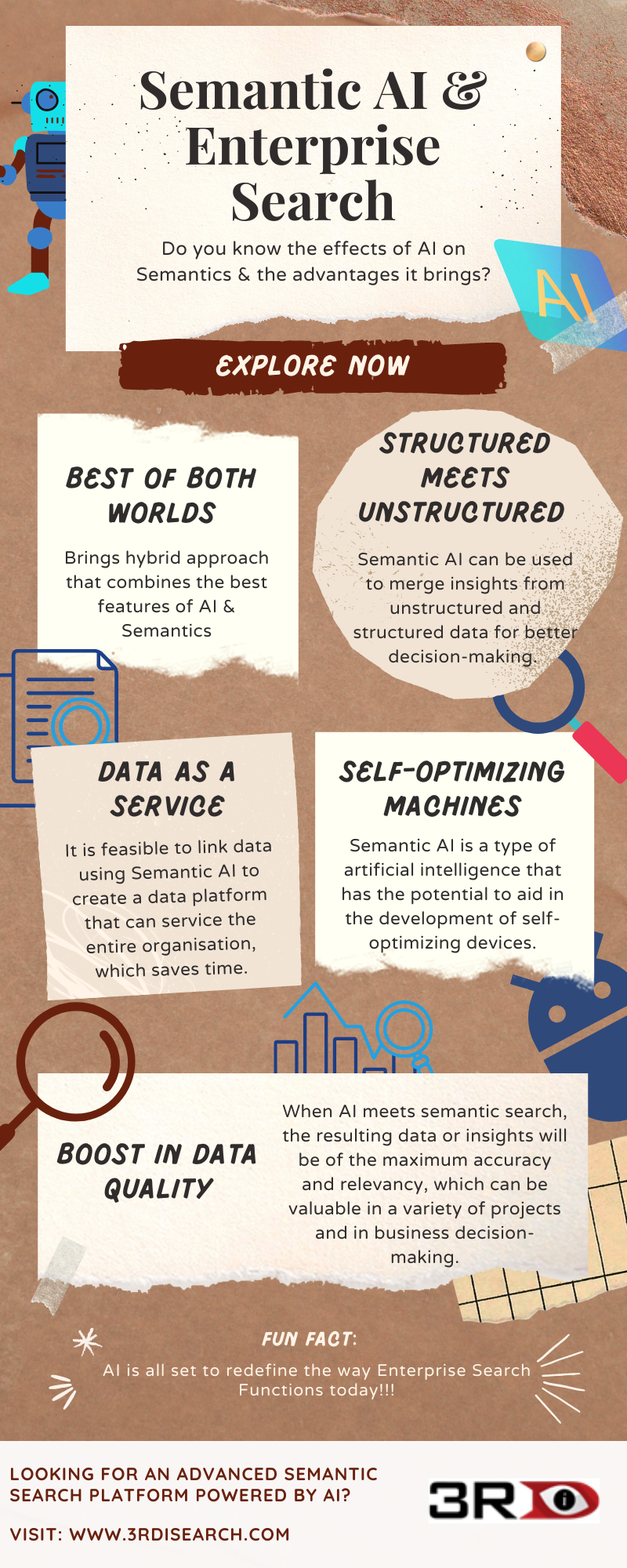
Infographics Blog on How AI Powers Semantic Search for the New Age Enterprise Search Tool
Today AI is a significant advanced technological concept with ramifications across all domains and industries. It's the technology that allows machines to think, reason, and make decisions in the same way that people do. AI holds a world of possibilities and has the potential to change the way we view and interact with machines, as fascinating as that may sound. Artificial intelligence (AI) is the key to innovation, and it may be utilised to create game-changing applications.
When it comes to semantic technology, we all know that it is a technology that has transformed the search domain in general, and corporate search in particular, in its own unique way. Semantic search technology is now used in advanced semantic search software like 3RDi Search. The fact that the majority of organisational data is unstructured makes semantic search software critical for successful analysis and management of enterprise data. This means that traditional methods will not be able to analyze the data. Furthermore, because the data is not optimised, it is impossible to extract hidden information using keyword-based methods.
We get Semantic AI when AI meets Semantic technology. Semantic AI is simply semantic search powered by AI, and it comes with a host of benefits that can be applied across the organization database. The five most important advantages of semantic AI for businesses are listed in the infographics below.

1] Offers the Best of Both Worlds
Semantic AI is a combination of symbolic and statistical AI technologies that allows everyone involved to choose from a variety of methods in order to achieve a goal. There are a number of techniques to pick from when AI and semantics are combined, which offers everyone in charge of the project even more alternatives. Furthermore, AI can only improve any semantic technological concept. This is also known as the hybrid approach, because it combines and brings the best features. This is one of the key advantages offered by the new age text mining software powered by semantic technology.
2] Structured Data Meets Unstructured Data
The majority of text mining software nowadays are involved in evaluating optimized structured text and unstructured data separately. Semantic AI, on the other hand, has the potential to change this, as it can be used to merge insights from unstructured data with those from structured data, allowing for better decision-making. Data in several formats can be made accessible collectively for further analysis using semantic AI. This aids in the development of a more inclusive database through a powerful semantic search software.
3] Data as a Service
It is feasible to link data using Semantic AI to create a data platform that can service the entire organisation. This reduces the amount of time and effort needed to develop data sets for each application or use case. Semantic data lakes, in fact, can be used as a source of high-quality data that can then be linked to internal company data as well as data from multiple platforms. This information can be utilised to efficiently train systems for machine learning and is available with the leading text mining software.
4] Possibility of Self-Optimizing Machines
Semantic AI is a type of artificial intelligence that has the potential to aid in the development of self-optimizing devices. A machine that optimises itself is known as a self-optimizing machine. Machine learning can aid in the creation of knowledge graphs, which improves the machine’s "learning" experience. Semantics and AI can work together this way to create the next generation of semantic search software that don't rely on humans to teach them new words.
5] Boost in Data Quality
When AI meets semantic search, the resulting data or insights will be of the maximum accuracy and relevancy, which can be valuable in a variety of projects and in business decision-making. The AI also improves the semantics categorization feature, allowing the entities in the data to be more thoroughly classified as needed. This feature of the new age semantic search software just improves the data's usefulness.
Today's businesses face a barrier in obtaining meaningful data that can be easily processed for analytics, and semantic AI provides the technology to make this feasible right from the start of the data lifecycle. What distinguishes semantic AI from other "machine learning algorithms" is that it combines the benefits of AI with semantics, opening up a world of possibilities in data analysis with the new age semantic search software like 3RDi Search.